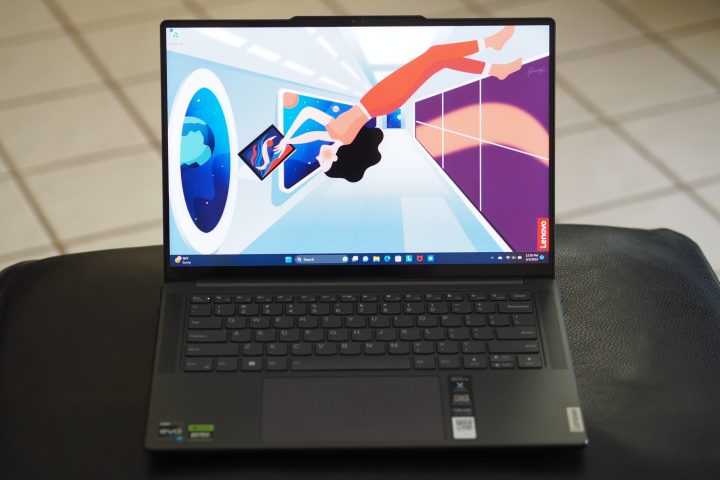
Several of Apple’s latest MacBooks are on our list of the best laptops around, and the MacBook Pro 14 is arguably the best 14-inch laptop you can buy today. Any new machine that wants to compete has to offer an incredibly compelling combination of features and value.
Lenovo’s Slim Pro 9i 14 is a laptop that’s obviously aimed directly at the MacBook. It has some powerful components inside and it performs just as well. It’s also less expensive. Unfortunately, even those things fail to give it a leg up.
Specs and configurations
| Lenovo Slim Pro 9i 14 | Apple MacBook Pro 14 | |
| Dimensions | 12.9 inches x 9.64 inches x 0.85 inches | 12.31 inches x 8.71 inches x 0.60 inches |
| Weight | 3.7 pounds | 3.5 pounds |
| Processor | Intel Core i7-13705H | Apple M2 Pro (10-core, 12-core) Apple M2 Max (12-core) |
| Graphics | Nvidia GeForce RTX 4050 Nvidia GeForce RTX 4060 |
16-core GPU 19-core GPU 30-core GPU 38-core GPU |
| RAM | 32GB LPDDR5X-6400Mhz | 16GB 32GB 64GB 96GB |
| Display | 14.4-inch 16:10 3K (3072 x 1920) mini-LED touch, 165Hz | 14.2-inch 16:10 Liquid Retina XDR 3024 x 1964 |
| Storage | 1TB PCIe SSD | 512GB SSD 1TB SSD 2TB SSD 4TB SSD 8TB SSD |
| Touch | Yes | No |
| Ports | 2 x USB-C with Thunderbolt 4 2 x USB-A 3.2 Gen 1 1 x HDMI 1 x 3.5mm audio jack 1 x SD card reader |
3 x USB-C with Thunderbolt 4 1 x HDMI 2.0 1 x 3.5mm audio jack 1 x SD card reader |
| Wireless | Wi-Fi 6E and Bluetooth 5.2 | Wi-Fi 6E and Bluetooth 5.3 |
| Webcam | 5MP with infrared camera for Windows 11 Hello | 1080p |
| Operating system | Windows 11 | MacOS Monterey |
| Battery | 75 watt-hour | 70 watt-hour |
| Price | $1900+ | $1,999+ |
| Review | 3.0 out of 5 stars | 4.5 out of 5 stars |
Currently, there’s just one configuration of the Slim Pro 9i 14 available. It’s $1,900 for a Core i7-13705H CPU, 32GB of RAM, a 1TB SSD, and a 14.5-inch 3K Mini-LED display. Other configurations are likely, including the option for slower CPUs and an RTX 4060 GPU.
The MacBook Pro 14 has a wider range of options. It’s more expensive from the outset, at $2,000 for an M2 Pro processor with 10 CPU cores and 16 GPU cores, 16GB of
So, keep this price difference in mind when we talk about performance.
Design
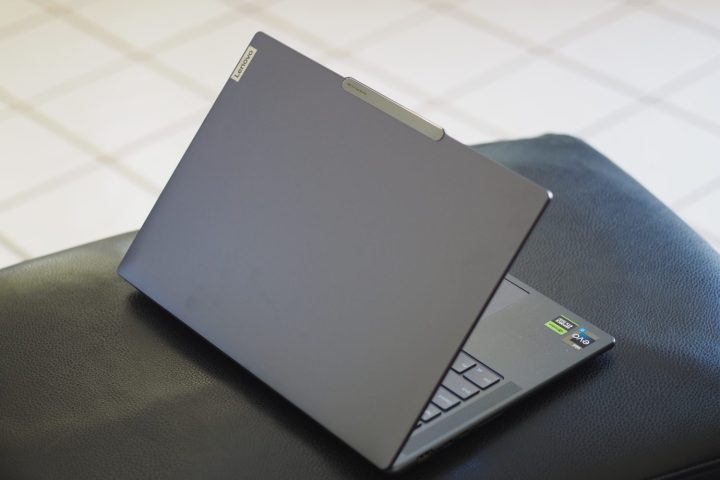
The Slim Pro 9i 14 inherits the rounded design of its lower-end sibling, the Slim 9i, meaning it has a simplistic design that’s quite attractive and comfortable to use. It’s made of aluminum and doesn’t bend, flex, or twist, marking it as one of the best-built
Interestingly, both
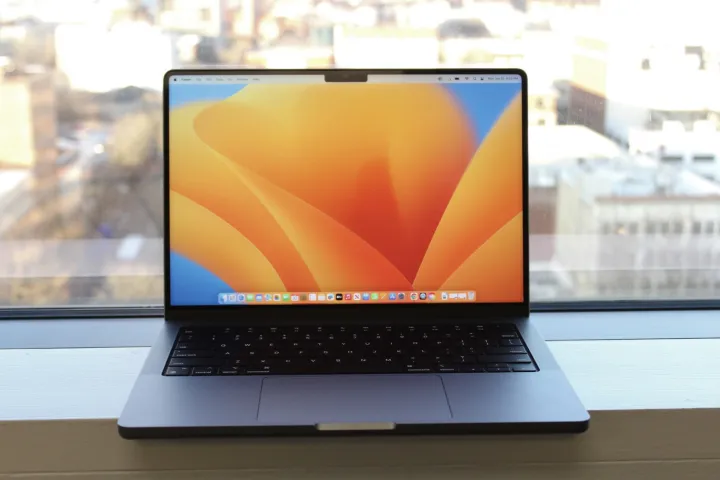
The MacBook Pro 14 has the best keyboard available on a laptop today, Apple’s Magic Keyboard. It provides large keycaps, excellent key spacing, and switches that are consistently precise and snappy. The Slim Pro 9i 14 has slightly deeper switches that are also light and precise, with sculpted keycaps and equally good key spacing. The MacBook’s Force Touch haptic touchpad is superior, with greater precision, the ability to use the entire surface for clicking, and extra features. The Lenovo’s mechanical touchpad is spacious and works well, it’s just not as good as Apple’s.
The Slim Pro 9i 14 has more legacy connectivity support, while the MacBook Pro 14 has an additional Thunderbolt 4 port. The MacBook also uses Apple’s MagSafe 3 charger, which frees up a port and provides protection again possible damage. Both
Finally, the Lenovo has a higher-resolution 5MP webcam, but Apple’s optimizations of the MacBook’s 1080p image are also excellent. Both provide great quality. The Slim Pro 9i 14 has an infrared camera for Windows 11 Hello support, while the MacBook Pro 14 uses a Touch ID fingerprint reader embedded in the power button. Both allow for quick and easy logins without entering a password.
Performance

The Slim Pro 9i 14 uses a 45-watt Intel 13th-gen CPU, the Core i7-13705H with 14 cores (six Performance and eight Efficient) and 20 threads. It’s a fast performer in both productivity and creative tasks. The laptop is also equipped with the Nvidia GeForce RTX 4050, an entry-level GPU that can speed up many creative processes.
The MacBook Air 14 that we reviewed used Apple’s top-end M2 Max with 12 CPU cores and 38 GPU cores. It also was stocked with 64GB of fast
The M2 Max is a fast processor, but the Core i7-13705H is also quick, especially in the Slim Pro 9i 14’s performance mode. The two
Either laptop will handle demanding workflows. It’s possible the MacBook Pro 14 will perform better in some other creative applications, but in this one at least, the Slim Pro 9i 14 manages to keep up.
| Lenovo Slim Pro 9i 14 (Core i7-13705H) |
Apple MacBook Pro 14 (M2 Max) |
|
| Geekbench 5 (single/multi) |
Bal: 1,898 / 11,691 Perf: 1,893 / 12,780 |
Perf: 1,973 / 14,596 Perf: N/A |
| Handbrake (seconds) |
Bal: 92 Perf: 74 |
Bal: 85 Perf: N/A |
| Cinebench R23 (single/multi) |
Bal: 1,913 / 14,024 Perf: 1,906 / 15,680 |
Bal: 1,608 / 14,789 Perf: N/A |
| Pugetbench Premiere Pro (higher is better) |
Bal: 837 Perf: 1,067 |
Bal: 1,093 Perf: N/A |
Display and audio
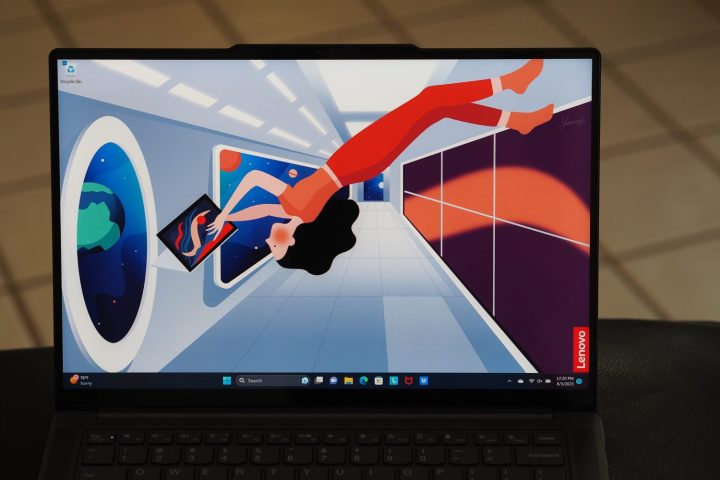
Both
In a nutshell, when Windows is running in default standard dynamic range (SDR) mode, Mini-LED displays are plenty bright and colorful but the contrast is lacking. Switch Windows to
In its default XDR mode, the MacBook Pro 14’s Mini-LED display provides a better balance, with brightness that’s not as high as the Slim Pro 9i 14’s (which is one of the highest scores we’ve seen on a laptop), but with much deeper contrast and inkier blacks. Play
Both displays are at least excellent for productivity work and very good for creators. But Apple is doing a much better job with Mini-LED.
| Lenovo Slim Pro 9i 14 (Mini-LED) |
Apple MacBook Pro 14 (Mini-LED) |
|
| Brightness (nits) |
708 | 511 |
| AdobeRGB gamut | 100% | 100% |
| sRGB gamut | 87% | 89% |
| Accuracy (DeltaE, lower is better) |
1.17 | 1.13 |
| Contrast ratio | 2,710:1 | 35,450:1 |
The MacBook Pro 14’s quad speakers also sound much better than the Slim Pro 9i 14’s. In fact, the MacBook provides the best audio on a 14-inch laptop, period. There’s deep bass and the clearest mids and highs around, with tons of distortion-free volume. The Slim Pro 9i 14’s audio is fine, but it’s not in the same class.
Portability
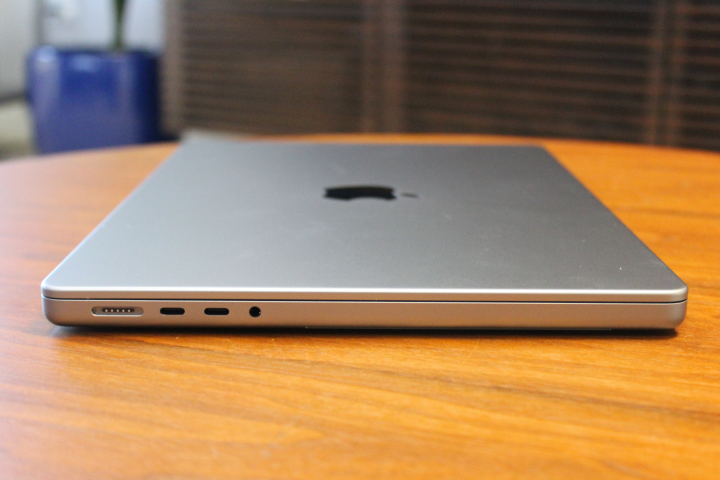
The MacBook Pro 14 is slightly less narrow and wide and it weighs slightly less. The biggest difference, though, is in thickness. The Slim Pro 9i 14 is a rather chunky 0.85 inches compared to the MacBook Pro 14’s 0.60 inches. Both are portable, but the Apple is a lot thinner.
Battery life is another story entirely. While the M2 Max is a very fast processor, it’s also incredibly efficient. The MacBook Pro 14 managed almost 20 hours of web browsing, compared to the Slim Pro 9i 14 at less than five. We didn’t benchmark using our video-looping test, but those results would have been even higher.
Apple managed to pack a superfast processor into its MacBook Pro lineup that beats the vast majority of Windows
| Lenovo ThinkPad X1 Yoga Gen 10 (Core i7-1260P) |
Lenovo ThinkPad X1 Yoga Gen 11 (Core i7-1355U) |
|
| Web browsing | 4 hours, 54 minutes | 19 hours, 20 minutes |
The MacBook Pro 14 is worth the extra money

Yes, the MacBook Pro 14 is considerably more expensive than the Slim Pro 9i 14, and the latter equals it in performance. But the MacBook lasts four times as long on a charge, and its display is superior even though both
Overall, the Slim Pro 9i 14 just can’t keep up with the MacBook Pro 14. It’s not as refined and its poor battery life and inconsistent display performance hold it back. The MacBook Pro 14 is worth the extra investment.
Editors' Recommendations
- These 6 tweaks take MacBooks from great to nearly perfect
- If you buy one MacBook Air alternative, make it this one
- The case for buying the M2 MacBook Air over the M3 model
- Which color MacBook should you buy? Here’s how to pick
- Why you should buy a MacBook Air instead of a MacBook Pro


